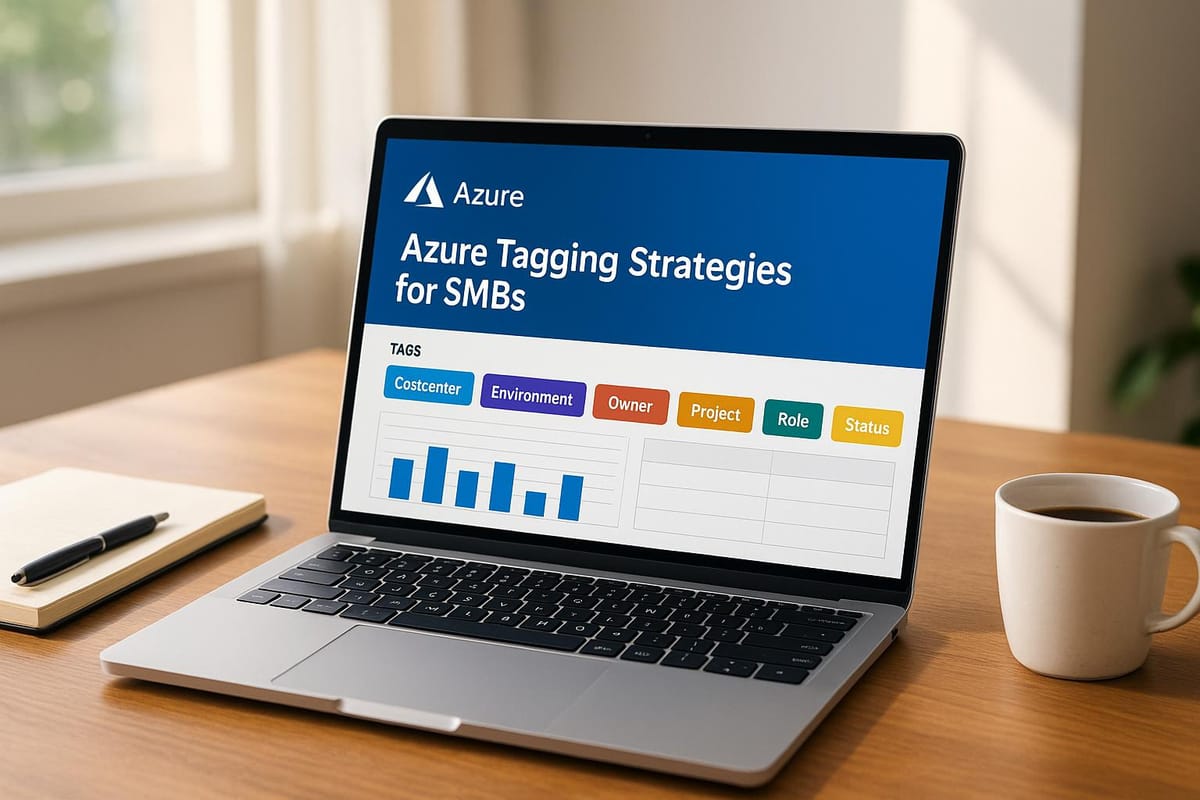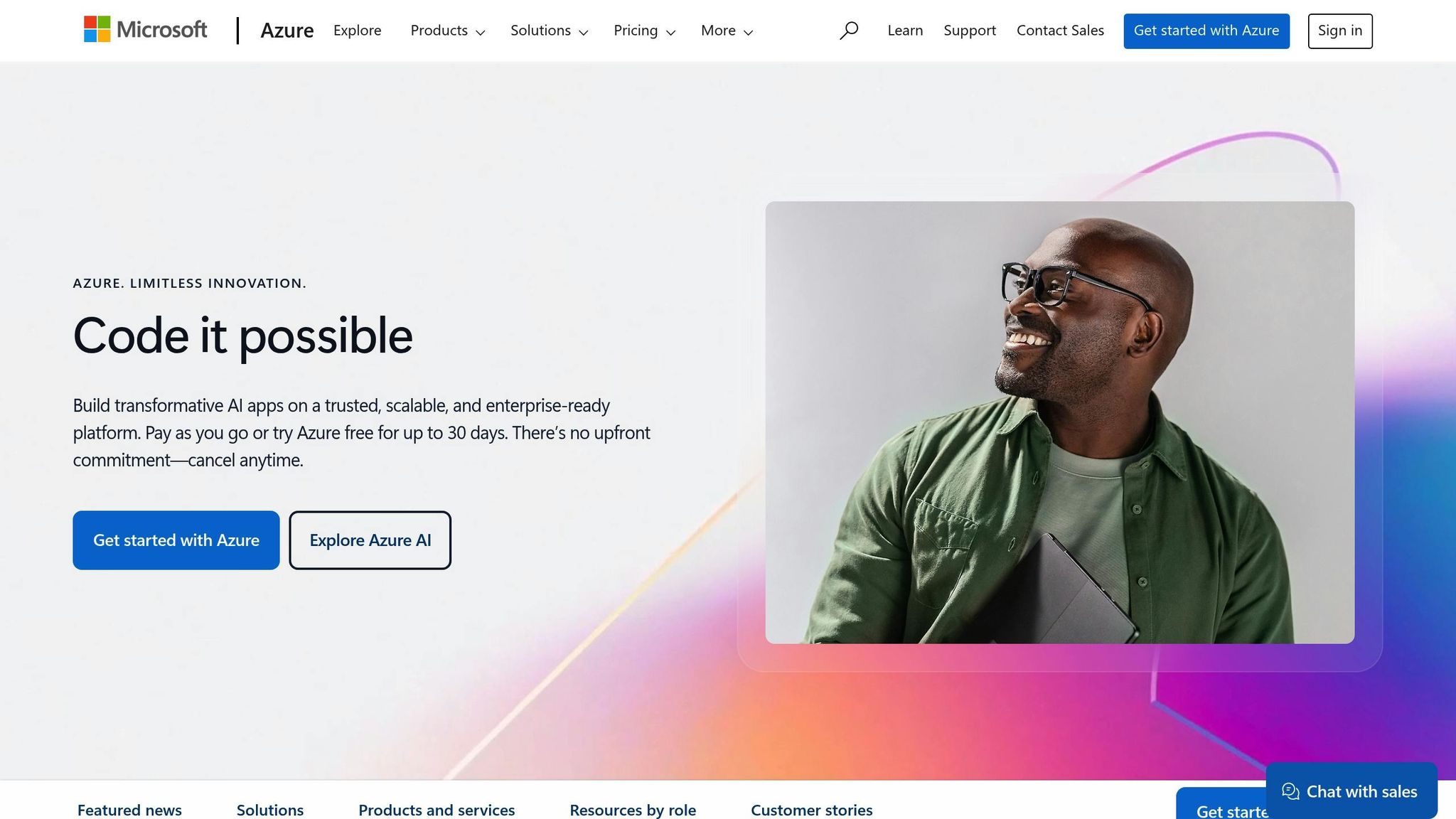Azure Tagging Strategies for SMBs
Learn how SMBs can effectively utilise Azure tagging strategies to manage costs, improve organisation, and ensure compliance with ease.

Azure tags are simple key-value pairs that help you categorise and manage your cloud resources. For SMBs, this means:
- Track Costs: Assign tags like
CostCentre:Marketingto monitor spending by department or project. - Improve Organisation: Use tags like
Environment:Prodto separate production from development. - Ensure Compliance: Add tags like
DataClassification:Confidentialto meet security and regulatory standards.
Key Benefits at a Glance:
- Cost Management: Spot unused resources and allocate budgets effectively.
- Resource Visibility: Quickly filter and group resources for better control.
- Automation: Use tools like Azure Policy to enforce tagging rules automatically.
Quick Example: Want to track the costs of a marketing campaign? Add tags like:
Project:LaunchCampaignCostCentre:MarketingEnvironment:Prod
This way, you can see exactly where your money is going and optimise your setup.
For SMBs, a strong tagging strategy can reduce cloud expenses by up to 18% and improve security, compliance, and overall resource management. Ready to get started? Read on for actionable steps and tools to implement Azure tags effectively.
Main Benefits of Azure Tags

Cost Tracking and Control
Azure tags make it easier for SMBs to allocate costs across departments, projects, and environments. By implementing a well-thought-out tagging system, finance teams can:
- Keep track of departmental spending
- Monitor costs tied to specific projects
- Identify unused or over-provisioned resources
- Create detailed cost reports for stakeholders
Here’s an example of how tags can be used effectively:
| Tag Type | Example | Business Impact |
|---|---|---|
| Cost Centre | CostCentre:Marketing | Tracks spending by department |
| Project | Project:LaunchCampaign | Monitors costs for specific projects |
| Environment | Environment:Prod | Distinguishes production from development |
For more tips on managing Azure costs, check out Azure Optimisation Tips, Costs & Best Practices.
By streamlining resource organisation, tags also improve overall resource management.
Resource Management
With Azure offering more than 200 products and services, managing resources efficiently is essential. Tags play a vital role by enabling:
- Quick filtering of resources
- Logical grouping of related services
- Easier management of resource lifecycles
- Better visibility across all resource groups
To maximise benefits, apply tags when creating resources and enforce their use with Azure Policy. This not only keeps your resources organised but also ensures compliance through dynamic reporting.
Compliance and Reports
Azure tags are invaluable for maintaining compliance and generating detailed reports. They allow SMBs to classify data, evaluate security impact levels, and prepare for potential security incidents. Key compliance benefits include:
- Automated enforcement of policies
- Simplified audits
- Improved security classification
- Enhanced reporting capabilities
Regularly auditing tags helps ensure compliance remains up to date. To manage compliance effectively, consider using these essential tags:
| Tag Category | Purpose | Example Value |
|---|---|---|
| Data Classification | Identifies sensitivity level | Confidential |
| Compliance Standard | Specifies regulatory framework | GDPR |
| Security Impact | Defines security priority | High |
| Audit Frequency | Sets review schedule | Quarterly |
Azure Tagging Guidelines
Planning Your Tag System
To make the most of Azure's tagging capabilities, it's essential to involve key stakeholders in the planning process. This ensures you identify the tags that will bring the greatest benefits to your organisation.
Here's a framework to guide your tagging strategy:
| Category | Purpose | Example Tags |
|---|---|---|
| Business Operations | Track costs and ownership | CostCentre, Owner, Department |
| Technical | Identify resource attributes | Environment, Application, Service |
| Security | Manage access and compliance | DataClassification, SecurityLevel |
| Lifecycle | Monitor resource status | CreatedDate, ExpiryDate |
"Accurately representing and naming your resources is essential for security purposes. If you come upon a security incident, it's critical to quickly identify affected systems, what functions those systems support, and the potential business impact." - Microsoft Learn
Once you've defined your key tags, establish clear naming conventions to ensure consistency across your resources.
Tag Naming Rules
Azure has specific restrictions on tags that small and medium-sized businesses (SMBs) need to be aware of:
- Tag names can be up to 512 characters long.
- Tag values are capped at 256 characters.
- Storage accounts have stricter limits, with tag names restricted to 128 characters.
- Each resource can support up to 50 tag name-value pairs.
To maintain a structured approach, follow these naming rules:
- Use prefixes to indicate resource types.
- Include environment indicators like
prod,dev, ortest. - Add geographical identifiers to specify location.
- Keep capitalisation consistent across all tags.
For example, the public IP address for a production SharePoint workload in the West US region could follow this pattern: pip-sharepoint-prod-westus-001.
Azure Tag Management Tools
Azure offers several tools to help you manage and enforce tagging effectively:
Azure Policy
This tool helps ensure consistency by enforcing specific tags, inheriting tags from resource groups, automatically replacing values, and maintaining naming standards.
- Query resources across multiple subscriptions.
- Identify resources that lack tags.
- Generate compliance reports.
- Analyse tag usage trends.
- Monitor expenses associated with tagged resources.
- Create detailed spending reports.
- Set up budget alerts based on tags.
- Track expenditures by department.
To get the best results, implement these tools in a systematic way and review their effectiveness every quarter.
How to really use Azure Tags!
Setting Up Azure Tags
After defining your tag policies and naming conventions, it’s time to put them into action. These steps will help you organise and manage your resources efficiently.
Creating Tag Categories
Start by identifying key categories that align with your business goals. Here’s an example table to guide you:
| Category | Required Tags | Purpose |
|---|---|---|
| Business | CostCentre, Department, Owner | Track spending and assign accountability |
| Technical | Environment, Application | Clarify the purpose of each resource |
| Security | DataClassification, SecurityLevel | Address compliance and security needs |
| Operations | CreatedDate, ExpiryDate | Keep tabs on resource lifecycles |
These categories should reflect your organisation’s specific needs while ensuring consistency across all resources.
Adding Tags to Resources
Once you’ve defined your tag categories, apply them consistently to your resources. Here are three straightforward methods you can use:
-
Azure Portal Method
Go to the specific resource in the Azure Portal, select "Tags" from the left-hand menu, and you can add, edit, or remove tags directly. This method is simple and user-friendly for smaller-scale tagging tasks. -
PowerShell Implementation
Use PowerShell to apply tags programmatically. Here’s an example:$tags = @{ "CostCentre"="UK-Finance-001" "Environment"="Production" "Owner"="IT-Operations" } Set-AzResource -ResourceId $resourceId -Tag $tags -
Azure CLI Approach
Alternatively, use Azure CLI for tagging:az resource tag --tags "Environment=Production" "CostCentre=UK-Finance-001" --resource-id $resourceId
These methods let you tag resources efficiently, whether you’re working on individual resources or managing them programmatically.
Tag Automation Methods
After manually tagging resources, you can streamline the process by automating it. Automation ensures consistency and reduces the risk of non-compliance.
-
Azure Policy Implementation
Set policies to enforce mandatory tags during resource creation, inherit tags from resource groups, or apply default tags based on subscription or resource type. This ensures that all new resources adhere to your tagging standards. -
Azure Functions Automation
Use Azure Functions to monitor and update tags automatically. For instance, you can track resources, handle ownership changes, or generate compliance reports.
For seamless automation, consider integrating your tagging strategy into your CI/CD pipeline. This approach ensures that all new resources are tagged correctly from the start, maintaining consistency across your Azure environment.
Advanced Tag Uses
Building on established tagging guidelines, advanced tagging techniques can unlock further operational advantages.
Tags for Cost Management
Advanced tagging strategies can play a big role in managing Azure costs by enabling precise tracking and monitoring of expenditures. When used effectively, these tags provide actionable insights to optimise resource usage. Here are some examples:
| Tag Category | Example Tags | Purpose |
|---|---|---|
| Financial | CostCentre: UK-Finance-001 |
Track spending by department |
| Lifecycle | ExpiryDate: 31/12/2025 |
Schedule resource retirement |
| Budget | BudgetCode: Q2-2025-MKT |
Align with financial planning |
| Usage | Utilisation: High |
Monitor resource efficiency |
For additional tips on cost-saving strategies, refer to Azure's optimisation guides and best practices.
Security and Compliance Tags
Cost-related tags focus on financial accountability, but security tags are essential for maintaining compliance and safeguarding sensitive data. These tags can help organisations stay aligned with regulatory requirements. For instance, in industries like healthcare, you might use tags such as:
| Security Level | Tag Configuration | Access Control |
|---|---|---|
| Restricted | DataClassification: PHI |
Restrict access to authorised personnel |
| Compliance | ComplianceStandard: HIPAA |
Enable audit tracking |
| Access | AccessLevel: Restricted |
Enforce role-based access control |
To ensure consistent application of these tags, you can use Azure Policy to automatically enforce tagging rules. This approach reduces the risk of untagged or miscategorised resources, helping to maintain compliance and protect sensitive data.
Tags for Growth Planning
Strategic tagging can also support business growth by providing clarity around resource scaling and performance needs. Tags designed for capacity planning and growth monitoring might include:
ScaleTarget: 2025-Q4GrowthRate: 25%RegionalExpansion: EU-WestLoadProfile: Peak-HoursScalingTrigger: CPU-80BackupPriority: Critical
Regular reviews and audits of your tagging strategy are crucial. They ensure that your cloud resources stay aligned with evolving business goals, making it easier to manage growth effectively and avoid potential bottlenecks.
Summary
Azure tagging offers SMBs a practical way to manage cloud resources, improve efficiency, and maintain compliance standards.
Here’s how Azure tags can make a difference for SMBs:
| Benefit Category | Impact | Key Consideration |
|---|---|---|
| Cost Management | Potential savings of up to 85% | Monitor spending by department and track resource usage |
| Resource Organisation | Up to 50 tags per resource | Simplify categorisation and streamline management |
| Compliance | Built-in inheritance support | Helps meet regulatory requirements and security needs |
| Automation | Policy-driven enforcement | Ensures consistent tagging across all resources |
These aren’t just theoretical benefits - real-world implementations have shown tagging can cut cloud expenses by 18%, with potential savings reaching £1.9 million.
To maximise these advantages, SMBs should focus on maintaining consistent tags through automation, enforcing mandatory policies, and regularly reviewing their tagging approach. Microsoft's Amy Colyer highlights the importance of this:
"Getting a good standard in place with Azure Policy can make sure you and your team keep an organised Azure environment in the short term and long term as the footprint grows. Security should always be first of mind as well."
By adopting flexible and scalable tag naming conventions, SMBs can create an intuitive system that grows alongside their needs.
For more insights on optimising Azure and managing costs, check out Azure Optimisation Tips, Costs & Best Practices.
FAQs
How do Azure tags help SMBs manage cloud costs more effectively?
Azure tags are a powerful tool for small and medium-sized businesses (SMBs) to organise and monitor their cloud resources. By assigning tags based on criteria like projects, departments, or cost centres, businesses can gain a clearer picture of their spending habits. This makes it much easier to allocate costs correctly and spot areas where savings can be made.
With this level of transparency, budgeting becomes more straightforward, and financial accountability improves. On top of that, proper tagging helps SMBs stay compliant, streamlines operations, and provides the insights needed to make smarter decisions about resource use and cost control. It’s an effective way for businesses to grow while keeping expenses under control.
How can SMBs use Azure tagging to improve compliance and security?
How Azure Tagging Supports Compliance and Security
For small and medium-sized businesses (SMBs), Azure tagging can be a game-changer when it comes to staying compliant and improving security. The first step? Develop a clear and consistent tagging strategy. This helps you categorise resources in a way that aligns with your organisation's compliance and security policies. Tools like Azure Policy can enforce required tags, ensuring resources are properly governed and meet regulatory standards.
Automation is another key element. By automating tag management, you minimise human error and maintain uniformity across all resources. But don’t stop there - make it a habit to audit and review your tags regularly. This ensures they stay relevant and in line with any changes to your policies.
Tags aren’t just about organisation - they’re practical too. Use them for cost tracking to gain better financial oversight or for security monitoring to identify risks. These insights can help you allocate resources more effectively and strengthen your risk management practices.
How can small and medium-sized businesses (SMBs) automate Azure tagging to ensure consistency and efficiency?
Small and medium-sized businesses (SMBs) can streamline their resource management in Azure by automating tagging with Azure Policy. This tool enforces tagging rules automatically, ensuring that every new resource created adheres to consistent tagging standards. To get started, establish a clear tagging strategy with standardised naming conventions and values.
For resources already in place, you can use PowerShell scripts or Azure CLI commands to apply tags in bulk. This approach not only saves time but also minimises the risk of manual errors. By leveraging these tools, SMBs can keep their resources organised, improve cost tracking, and maintain better operational oversight.




